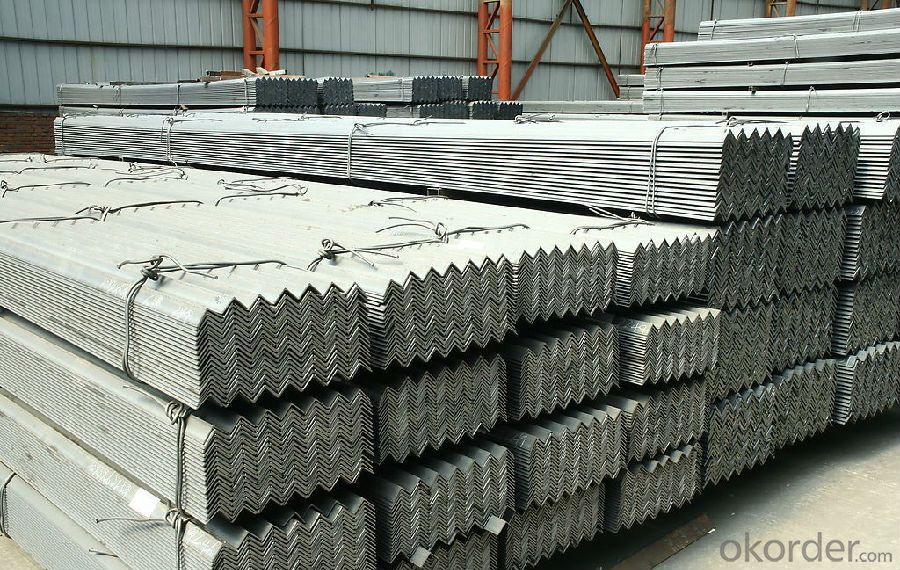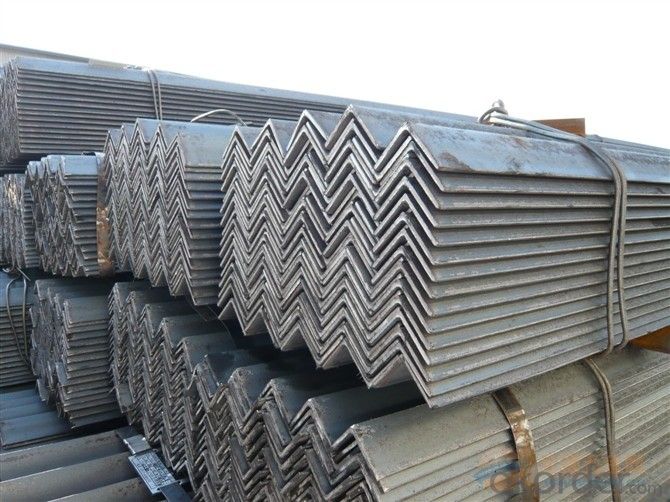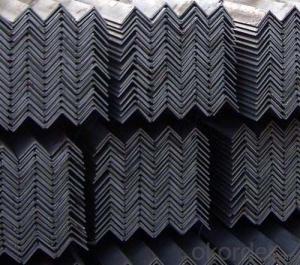Hot Rolled Steel Angle Bar with High Quality 25*25mm
- Loading Port:
- Tianjin
- Payment Terms:
- TT OR LC
- Min Order Qty:
- 25 m.t
- Supply Capability:
- 10000 m.t/month
OKorder Service Pledge
OKorder Financial Service
You Might Also Like
Product Description
Specifications of Equal Angle Steel
1.Standards:GB
2.Length:6m, 12m
3.Material:GBQ235 or Equivalent
4. Size:
Size (mm) | Mass (mm) | Size (mm) | Mass (mm) |
| 25*25*2.5 | 0.95 | 25*25*3 | 1.124 |
| 25*25*2.7 | 1.02 | 25*25*4 | 1.459 |
Usage & Applications of Equal Anlge Steel
Trusses;
Transmission towers;
Telecommunication towers;
Bracing for general structures;
Stiffeners in structural use.
Packaging & Delivery of Equal Angle Steel
1. Transportation: the goods are delivered by truck from mill to loading port, the maximum quantity can be loaded is around 40MTs by each truck. If the order quantity cannot reach the full truck loaded, the transportation cost per ton will be little higher than full load.
2. With bundles and load in 20 feet/40 feet container, or by bulk cargo, also we could do as customer's request.
3. Marks:
Color mark: There will be color marking on both end of the bundle for the cargo delivered by bulk vessel. That makes it easily to distinguish at the destination port.
Tag mark: There will be tag mark tied up on the bundles. The information usually including supplier logo and name, product name, made in China, shipping marks and other information request by the customer.
If loading by container the marking is not needed, but we will prepare it as customer request.
FAQ:
Q1: Why buy Materials & Equipment from OKorder.com?
A1: All products offered byOKorder.com are carefully selected from China's most reliable manufacturing enterprises. Through its ISO certifications, OKorder.com adheres to the highest standards and a commitment to supply chain safety and customer satisfaction.
Q2: How do we guarantee the quality of our products?
A2: We have established an advanced quality management system which conducts strict quality tests at every step, from raw materials to the final product. At the same time, we provide extensive follow-up service assurances as required.
Q3: How soon can we receive the product after purchase?
A3: Within three days of placing an order, we will arrange production. The shipping date is dependent upon the quatity, how many sizes you want and the plan of production, but is typically 30 to 45 days from the beginning of production.
Images:


*If you would like to get our price, please inform us the size, standard/material and quantity. Thank you very much for your attention.
- Q:Can steel angles be used for transmission towers?
- Yes, steel angles can be used for transmission towers. Steel angles provide structural strength and support, making them suitable for constructing transmission towers that need to withstand various weather conditions and carry heavy loads.
- Q:What are the common design codes or standards for steel angles?
- There are several common design codes and standards that govern the use of steel angles in structural design. These codes and standards ensure that the angles are designed and manufactured to meet certain safety and performance criteria. One of the most widely used design codes for steel angles is the American Institute of Steel Construction (AISC) Manual of Steel Construction. The AISC provides comprehensive guidelines and specifications for the design, fabrication, and erection of steel structures, including angles. This manual includes detailed information on the design strength, allowable stress levels, and geometric properties of angles. In addition to the AISC Manual, other design codes and standards may also be applicable depending on the specific project and location. These include international standards such as the Eurocode, British Standards (BS), and Australian Standards (AS). Each of these standards may have slightly different requirements for the design and use of steel angles, so it is important to consult the appropriate standard for the specific project. Furthermore, the American Society for Testing and Materials (ASTM) has established standards for the physical and mechanical properties of steel angles. These standards ensure that the angles meet certain quality and performance requirements. The most commonly used ASTM standard for steel angles is ASTM A36, which specifies the general requirements for carbon structural steel. Overall, the common design codes and standards for steel angles provide guidance on factors such as load capacity, strength, and safety considerations. Adhering to these codes and standards ensures that steel angles are designed and used in a manner that promotes structural integrity and reliability.
- Q:Can steel angles be used in fencing?
- Yes, steel angles can be used in fencing. Steel angles are commonly used as posts or rails in fencing systems due to their strength and durability. They provide stability and support to the fencing structure, making them suitable for various types of fences, such as chain-link, wood, or ornamental fences.
- Q:What is the maximum length of a steel angle available in the market?
- The maximum length of a steel angle available in the market can vary depending on the supplier and the specific type of steel angle being referred to. However, in general, steel angles are typically available in lengths ranging from 20 feet (6.1 meters) to 40 feet (12.2 meters). It is important to note that these lengths are commonly found for standard steel angles, but there may be customized options available that could exceed these lengths if required for specific projects or applications. It is advisable to consult with the supplier or manufacturer to determine the maximum length available for a particular steel angle.
- Q:What is the purpose of using steel angles in construction?
- Steel angles are commonly used in construction for several purposes. The primary purpose of using steel angles is to provide structural support and stability to various components of a building or structure. These angles are often used to reinforce corners, edges, and joints, adding strength and rigidity to the overall structure. Additionally, steel angles are used to distribute and transfer loads or forces within the construction. They help to evenly distribute the weight and stress across different parts of the structure, preventing any concentrated points of weakness. Moreover, steel angles are versatile and can be easily customized and fabricated to meet specific construction requirements. They can be cut, drilled, and welded, allowing for seamless integration into a wide range of construction projects. Furthermore, steel angles offer excellent durability and resistance to corrosion, making them suitable for both indoor and outdoor applications. They can withstand heavy loads, extreme weather conditions, and provide long-lasting support to the structure. In summary, the purpose of using steel angles in construction is to enhance the structural integrity, provide support and stability, distribute loads, and ensure the longevity of the building or structure.
- Q:How do you reinforce a steel angle for added strength?
- There are various ways to reinforce a steel angle for added strength. One effective technique involves welding additional steel plates or gussets to the flanges of the angle. These plates or gussets are typically placed perpendicular to the angle and welded along their edges to create a stronger connection. This helps distribute the load and improve the structural integrity of the angle. Another approach is to create a sandwich-like structure by bolting or riveting additional steel plates or angles to the existing one. These additional elements can be positioned on either side or even on top of the existing angle, depending on the specific requirements. Bolting or riveting them together ensures a secure connection and enhances the overall strength of the angle. Furthermore, bracing techniques can also be employed to reinforce a steel angle. This involves adding diagonal steel members, commonly known as braces, to the angle. The braces are typically attached to the angle at multiple points using welding or bolting methods. By doing so, these braces help redistribute the forces acting on the angle and prevent excessive deflection or bending, thereby increasing its strength. It's important to consider factors such as the load or force the angle will experience, the desired level of strength, and the available resources when choosing a specific reinforcement method. Seeking guidance from a structural engineer or a professional in the field is highly recommended to ensure the appropriate reinforcement technique is chosen and implemented correctly.
- Q:Can steel angles be recycled or reused?
- Certainly, steel angles have the ability to be recycled and reused. Steel, being extremely durable and valuable, is among the most frequently recycled materials worldwide. Once steel angles are no longer necessary or become scrap, they can be gathered, organized, and dispatched to recycling facilities. The recycling procedure entails melting down the steel angles to eliminate impurities, after which the molten steel is molded into fresh products. Recycled steel angles are applicable in numerous industries, including construction, automotive, and manufacturing, just like newly manufactured steel angles. This not only preserves natural resources but also aids in reducing energy consumption and greenhouse gas emissions linked to the production of new steel. Recycling steel angles is an efficient method to encourage sustainability and contribute to a circular economy.
- Q:What is the maximum deflection for a steel angle beam?
- The maximum deflection for a steel angle beam depends on various factors such as the span length, load applied, and the properties of the steel angle beam itself. To determine the maximum deflection, one must consider the beam's moment of inertia, elastic modulus, and the applied load. By using appropriate formulas and calculations, engineers can determine the precise maximum deflection for a steel angle beam in a given scenario. It is important to note that the maximum deflection should always be within acceptable limits to ensure the structural integrity and safety of the beam.
- Q:Can steel angles be used in the construction of theatres?
- Yes, steel angles can be used in the construction of theatres. Steel angles are versatile structural components that can provide support and stability to various elements of a theatre, such as stage platforms, lighting rigs, and seating structures. They are commonly used in the construction industry due to their strength, durability, and ability to withstand heavy loads, making them suitable for theatre construction projects.
- Q:How do you protect steel angles from moisture?
- Steel angles can be protected from moisture by applying a suitable coating or paint that acts as a barrier against moisture. Additionally, regular inspection and maintenance, including the removal of any rust or corrosion, can help prevent moisture damage.
1. Manufacturer Overview |
|
|---|---|
| Location | |
| Year Established | |
| Annual Output Value | |
| Main Markets | |
| Company Certifications | |
2. Manufacturer Certificates |
|
|---|---|
| a) Certification Name | |
| Range | |
| Reference | |
| Validity Period | |
3. Manufacturer Capability |
|
|---|---|
| a)Trade Capacity | |
| Nearest Port | |
| Export Percentage | |
| No.of Employees in Trade Department | |
| Language Spoken: | |
| b)Factory Information | |
| Factory Size: | |
| No. of Production Lines | |
| Contract Manufacturing | |
| Product Price Range | |
Send your message to us
Hot Rolled Steel Angle Bar with High Quality 25*25mm
- Loading Port:
- Tianjin
- Payment Terms:
- TT OR LC
- Min Order Qty:
- 25 m.t
- Supply Capability:
- 10000 m.t/month
OKorder Service Pledge
OKorder Financial Service
Similar products
New products
Hot products
Related keywords



























